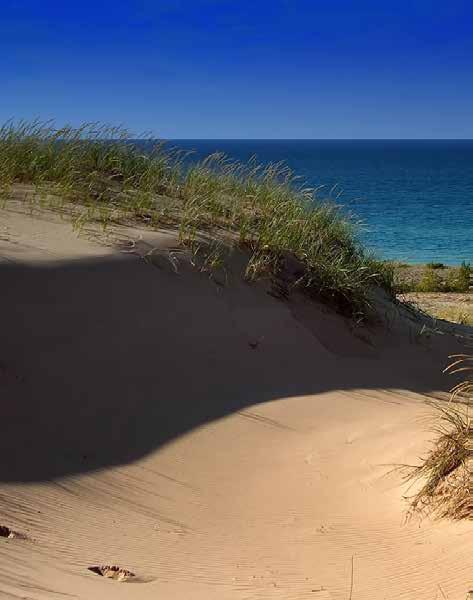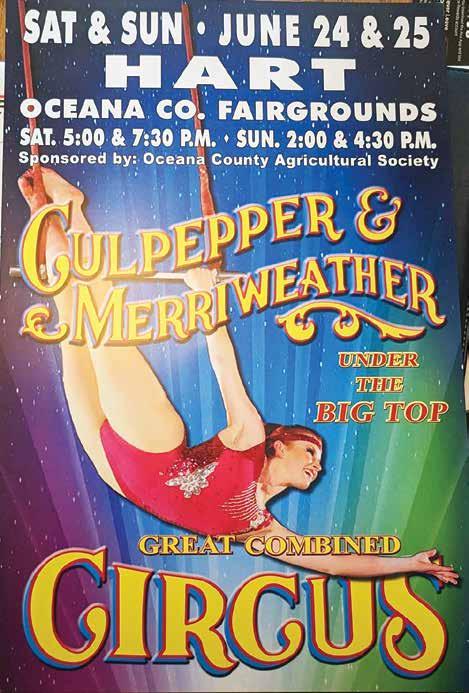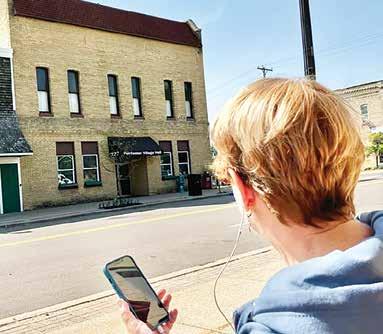
10 minute read
It takes a community to keep traditions alive
By Sharon Hallack The Oceana Echo Community Columnist
The 50th National Asparagus Festival (NAF) has passed, and for many of us, we’ve moved on to the rest of our summer. However, for those involved with making such a large event happen, plans are already in the works for next year’s festival.
The first “official” festival took place in Shelby in 1974 with the main events alternating between the City of Hart and the Village of Shelby until 2009. At that time the NAF Board made the decision to keep the festival in Hart with the thought it would be easier on the smaller board to execute the event in the same locality every year.
As times have changed and life has gotten busier, one comment I’ve heard over and over the past few years is, “Will the festival survive?” Some people who remember festivals of the past don’t want to see the tradition end. Others want to help, but aren’t sure how to get involved.
I’d like to offer some reasons why we’re seeing a decline in involvement and interest, as well as a few possible solutions.
We can all agree that in the last 20 years, our society has changed. People everywhere are working more, leaving precious little free time, and more and more events are competing for that free time. Not to mention how technology has changed things. We’ve gone from face-to-face communication and interaction to social media posts, online shopping and virtual meetings. While I use technology for many things in my life, I have noticed communication is different, shopping is different, work is different - it’s just not the same. I’ve said many times, the world’s problems cannot be solved with a social media post or an online fundraiser. The world needs engaged people.
The current NAF board is small, and the festivals in the past few years have been one-day events. But they have held things together for us and are to be recognized and commended. We don’t have to go back to the 1970s, but I think now is the time to think outside the box, come up with some new ideas or new ways of doing the same thing. The more people that get involved, the more ideas can be generated and more will be possible.
With more involvement, we will be building a stronger community in every way. One thing Oceana County can claim, something that’s not seen everywhere, is a true sense of community. That’s one thing technology can’t duplicate. It tries and may claim to have online “communities”, but that’s not real “community”. Let’s face it, we don’t really feel connected online. We might have hundreds of people in our contact lists, but we don’t feel connected to many of them. A real connection comes with in-person contact. The phrase “we’re better together” really applies here. Want to feel connected and build community? Get involved - working, playing, organizing, planning, trying and failing, trying and succeeding - in person.
When the NAF was in its infancy, EVERYONE was involved, and I mean EVERYONE. Every business donated money or in-kind services. Community groups donated volunteers. Many constructed handmade floats or sponsored an activity at the festival. Folks eagerly volunteered to run for board positions and worked hard to make the festival successful. Subcommittees were formed, and as a result, the festival flourished.
The point of this column is not to complain about what used to be or criticize the way anything has been done. Instead, I want us to remember the past festivals with great pride, the memories we’ve made, the bonds we’ve formed. I want us to look to the future.
Remember when the NAF was the major event of the summer in Oceana County? The world stopped for that week. No one left town to go on vacation, had graduation open houses, weddings or scheduled any other large events that weekend. Farms were in full-on harvest mode, but they usually managed to schedule asparagus picking so family and employees could attend the parade and festivities if they wanted. People talked about it and planned it for months.

There were more events on the schedule than one could possibly attend; held from Pentwater to New Era and Walkerville to Silver Lake and every point in-between. There was definitely something for everyone; from food and sports events to fine arts shows and musical events. It isn’t that people don’t want to attend certain events anymore, it’s more a matter of manpower. With a limited number on the board and basically no sub-committees, there is only so much six people can do and do well.
We’re all short on time. However, people tend to make time for what is important to them. This is important folks! We’ve got something unique here in Oceana. We grow, harvest and ship more pounds of asparagus than any other region in the state. We’ve got a beautiful area that people travel to from far and wide to experience. That’s something to promote and celebrate. The National Asparagus Festival is good for our producers, processors, downtown businesses, tourism centers and our families. Let’s not ask ourselves “if” we can get involved. Let’s ask ourselves “how” can we be involved?
And we don’t have to all make huge commitments. If we all did a little, together we could accomplish a lot. We could add members to the board, form committees and divide up the tasks, or donate much-needed funds to help pay for larger events. The groups we are already involved in (church, clubs, sports teams, service organizations, etc.) could work together to sponsor an event or parade entry. More businesses could offer weekend specials. Major events could be planned for another weekend so as not to compete. We could share the festival and the message of Oceana County asparagus with everyone in our contacts. The list is endless.
Promoting asparagus and the festival is not only good for our community, it’s also good for the soul. How do you feel when you’re walking through the art and crafts fair, sampling asparagus dishes at the food show, or waving and clapping at the parade? Admit it, you feel good. You forget your worries and stresses for a while. You see into friends you haven’t seen in months (or years). You take pride in your community. You might even think, “I want to do this.”
What talents do you possess that you could share to make next year’s NAF better - fundraising, organizing, communication? What hobbies do you enjoy that could be turned into a festival event - sports, art, entertainment, cooking? What time could you sacrifice - a few hours, a few days, a few months? I’m even coming up with a few ideas of my own for how I could be more involved in the years to come. We all have something to contribute. Working side-by-side takes teamwork, give and take, but the rewards are so worth it. Next year’s festival is a little over 11 months away and its success is dependent on all of us. It will take a community.
Note: The National Asparagus Festival board will start meeting again in September the second Tuesday of every month at 6 p.m. in their office located in downtown Hart. Be sure to check out their Facebook page “National Asparagus Festival” or contact them at www.nationalasparagusfestival.org for meeting updates or to become involved. More volunteers and ideas are welcome!
Take the Hancock History Self-Guided Audio Tour
Would you like an easy way to reminisce or expand your knowledge about Pentwater history? The Pentwater Historical Society (PHS) is pleased to announce the new Hancock History Self-Guided Audio Tour. It’s free and easily accessed on one’s cell or hardline telephone simply by dialing (231) 720-0291, and following the prompts.

Each of the six audio narratives runs between five and nine minutes. They describe some of the history that occurred on six blocks of Hancock Street – the 500 block between Fifth and Sixth streets, the 400 block, the 300 block, the 200 block, the 100 block, and the block between Lowell and First. As the weather improves, each narrative might best be enjoyed while sitting in front of the Village Marina, water tower, Chamber of Commerce, Village Green, Hancock Building, Cosmic Candy, Village Hall, and the Methodist Church. There, residents and visitors can imagine Pentwater’s early days as they listen on cellphones, perhaps through an earpiece, while sipping a beverage.
One can listen to all six narratives in succession, starting at the Village Marina and entering 500#, either while strolling along Hancock Street or sitting on a bench. Just follow the prompts. It’s perfect for dog walkers. Or one can access individual recordings anytime while sitting on a bench waiting for a shopper, or just people-watching. Simply enter 5-0-0-pound (# KEY) to learn some history about the 500 Block of Hancock, 4-0-0-pound for some history about the 400 block, and so forth. To learn some history between Lowell and First streets, one must enter 9-9-pound.
“It was fascinating to compile and record these narratives over the winter,” said Ron Beeber, a PHS volunteer docent. “A lot of the content is drawn from past issues of PHS newsletters that are posted on the pentwaterhistoricalsociety.org website under the research heading. Some landmarks had to be located by matching content to historic photos of the Village.”
The content heard in these six recordings is just the tip of the iceberg of what’s known about Hancock Street’s history. The PHS hopes this Self-Guided Audio Tour will trigger many Pentwater memories, and that listeners will post some on the Pentwater Historical Society Museum’s Facebook page. What a treasure trove of memories!

The idea for sharing Hancock Street history this way was inspired by Mary Schumaker’s suggestion a few years ago that the PHS offer docent-led tours along Hancock Street during the holiday shopping season. It would build upon the popularity of the summertime History Cruise on Pentwater Lake. PHS trustees Bart Zachrich and Beth Russell conducted a few strolls, but encountered some real wintry weather. Then, two years ago, a few docent-led tours were offered on already-busy summer Saturday mornings. So the Historical Society hopes this Self-Guided Audio Tour proves to be more convenient. One can just add (231)7200291 to their cellphone “Contacts” - labeled as “PHS” - and listen anytime, from anywhere.
Flavius Littlejohn describes Michigan of days gone by
By Caleb Jackson The Oceana Echo Community Columnist
During Oceana’s infancy, Flavius J. Littlejohn was the Circuit Court Judge of Allegan County. In those days, Littlejohn and his team of attorneys would traverse their circuit all the way from Allegan up to the Straits of Mackinaw. He was also the first judge to hold the seat in Oceana, but he is also known for another thing. He published a book.
Littlejohn was fascinated by the lore and oral traditions of the Native Americans. After 40 years of residence in West Michigan, he had heard enough tales to publish his own book called, “Legends of Michigan and the Old North West,” in 1875. I guess technically, that is the shortened title. The full title is “Legends of Michigan and The Old North West; A Cluster of Unpublished Waifs, Gleaned Along the Uncertain, Misty Line, Dividing Traditional from Historic Times,” but that’s a bit of a mouthful.
Littlejohn was known through his circuit for his eloquent speech, and this certainly comes through in his book, making for a delightful read. His opening chapters are concerned with the Shawnee and Potawatomi (or, as he spells it, “Pottowatomie”) War, but he first sets the scene by giving a brief description of the land, wildlife, and people in the region as they existed prior to the arrival of European settlers, and this is what I would like to share with you today.
“…A bird’s-eye view of this forest land would have disclosed scenes of rare loveliness, and rich in material, though undeveloped resources. With its genial climate, its productive soil, and its undulating surface, dotted and gemmed with myriads of tiny lakes, and traversed east and west by noble rivers; with its burr oak plains and its white oak ridges; its ranges of hard wood timber, and its richly clustered glades of pine skirting the northern water courses; with its numerous prairies, blooming with an indigenous annual flora, of gorgeous coloring; above all, with a never-failing supply of fish in its rivers and lakes, and an abundance of choice varieties of game in its forest; the Peninsula State was then evidently and in fact, a very paradise for the various tribes…who for ages had been its roaming denizens.” (Littlejohn, 1875, pp. 9-10)
The above text is Littlejohn’s description of the Lower Peninsula, and it is something that I think will ring true with any Michigander, even today. From here, he divides the land according to the Native Nations and where they reside, beginning with the Eastern side of the state. “Those of the Saginaw region were in part Chippewas, and in part Hurons, the conquerors and successors of the Osaukies,” Littlejohn wrote. It is interesting to note that the spelling for most of the Native Tribes used by Littlejohn are often quite different from how we know them today. The Osaukies that he refers to are now known as the Sauk.
Next, he moves into the more familiar territory of the Ottawas, whom he describes as being “both numerous and powerful.” This tribe was “firmly seated” from the Straits of Mackinaw down to the Kalamazoo River “with its affluents.” This, of course, encompasses our region of Western Michigan here in Oceana. It is also humorously congruent with the author’s own circuit when he served as Judge of the Circuit Court. Maybe those old Indian Trails were of some use to Mr. Littlejohn. Of their government, he says, “the Ottawas were separated into several independent clans or tribes, each ruled by its own distinctive chief.” However, he goes on to say that whenever there was a threat to the welfare of the nation, these tribes held a “grand council” where “ruling chiefs met as equals in voice and votes,” and the various clans then acted “in concert as confederates.” Moving further south, into the region of the Paw Paw and St. Joseph rivers, we have the Potawatomi. “The Pottowatomies were a strictly homo-geneous people,” Littlejohn wrote, “and… were governed in all their public policies and movements, both of peace and war, by Pokagon their head chief.” Lastly, he tells us of the Shawnees, who were “clustered up and down the Wabash Valley,” but as we are moving further and further out of our own region and indeed out of the state of Michigan itself, I am afraid I will have to stop here.
The Native Nations of America employed no writing system, and so their legends and histories were passed down like so many others, by word of mouth. With Littlejohn being, as he described himself, “ever fond of tracing the peculiar characteristics, and curious in observing the distinctive traits developed by the various races of the human family…” it is no wonder that the rich oral tradition was deeply intriguing to him. If you dig through old books for a snapshot of what Michigan of old might have looked like, you will find time and time again romanticized descriptions of an almost idyllic landscape, and rightly so. The area is beautiful and serene to this day, but in just a few pages describing the lay of the land prior to European settlement, Littlejohn left a touch of personality that was sorely needed.







